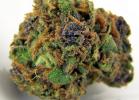
The modern American landscape seemed like a pipe dream just a decade ago. The White House is occupied by a person of color, marriage is no longer confined by Judeo-Christian concepts of love and cannabis has gone from being a despicable “gateway drug” to a legitimate component of the economies of several states.
One can only admire the evolution underway in the world of cannabis agriculture and consumption. As soon as American innovators saw the budding legitimacy of big-time cannabusiness, they got to work ushering in a new age of grow and intake technology to meet and even create demand.
Consumption 2.0
Dabs are an enhanced way to take advantage of waterpipe technology. Buds are broken down and condensed into highly potent putty-like substances. The most efficient method of consumption is heating small chunks - “dabs” - on an element (nail) attached to a bong. However, the rig and propane torch required to heat the nail may intimidate the casual user.
Enter the vape pen, which has its origins in the vaporizer devices of years past. Tech gurus have been able to shrink weed vaporizer technology down to affordable, handheld tools virtually indistinguishable from e-cig devices. In fact, you’re likely to see these pot pens marketed ambiguously as “herb” devices to allow for sales in states where cannabis is not yet legal or decriminalized.
Then, there’s edibles, which have been around since the world’s first pot brownie and probably longer than that. Infusion technology is expected to make great strides in 2016, with a large portion of the cannabis market preferring to eat rather than inhale. Just about any foodstuff or beverage can be infused with cannabinoids.
Grow 2.0
Keeping marijuana plants properly cooled during the growing process has been historically challenging when done indoors. On an industrial scale, it’s practically impossible to successfully grow outdoors, forcing growers to artificially cool plants with HVAC systems. This allows plants to grow in humid conditions, with regular air conditioning and ventilation.
The need for proper cooling is due to the high-intensity lights being used to trigger photosynthesis, which are kept on nonstop for the first half of the growing process, followed by a 12 hours on and 12 hours off schedule. It’s necessary for THC cultivation, but stunts the growth of the plants.
Cannabusiness 2.0
The catch for legalization of cannabis is strict, no-nonsense regulations over the industry. This means every plant has to be tracked and accounted for at all times. To make this policy as efficient as possible, growers are adapting inventory control methods not unlike the kinds seen in grocery stores: RFID tags, scanners and the like.
The technology impacting “Big Weed” and the users who enjoy the fruits of their labor has, in a short amount of time, indicated the potential for even greater evolutions in the industry in years to come.
Feature article provided by Jane Brown.






